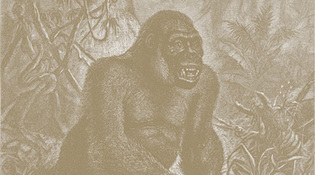 loading
loading
The missionary and the gorilla Culver PicturesThe US and European public were fascinated by the gorilla. This unsigned engraving probably dates from 1898. View full imageHe would feel differently later. Indeed, their correspondence suggests that, beneath their courtly manners, both Savage and Wyman cared deeply about being first. In February 1848, Richard Owen published what he apparently took to be the first scientific description of the new species -- based on skulls supplied to him by Stutchbury. Wyman later admitted to being "not a little surprised" by this maneuver, as Owen "must have known that we either had or intended to describe the crania & bones brought back by yourself from Africa." In fact, he could hardly have missed it: the placeholder notice suggested by Wyman had actually appeared the previous October in an issue of Annals & Magazine of Natural History dominated by Owen's own article on the plesiosaurus. It was the first printed reference to the gorilla, under the headline "New Orang-Outang," and announced that a description would appear shortly in the Journal of the Boston Society of Natural History. When Savage saw Owen's article, he reacted with uncharacteristic rancor -- directed not at Owen but at Stutchbury. Only a few years earlier, Savage had arranged to have the body of a pregnant chimp packed in a cask and shipped to Stutchbury. "I scarcely know how and certainly never can return you proper thanks," Stutchbury had replied, "for the very kind manner you responded to the desire of a perfect stranger." But he had never even bothered to answer Savage's letter from Gabon seeking information about a new "Orang." Instead, he had asked Wagstaff and other captains to bring him specimens. It looked to Savage as if Stutchbury had leapt at the possibility of a huge new primate and done his best to steal credit for the discovery. In a note to Wyman, Savage wrote, "Had I not taken the precaution . . . at your suggestion to announce. . . the discovery" through a British colleague, then "Mr. Stutchbury's efforts" would have given the discovery "to himself or Capt. Wagstaff." From Owen's perspective, there was nothing improper about it. His article freely recounted how Stutchbury "had requested some of the captains of vessels trading from Bristol to the Gaboon river to make inquiries respecting the species and endeavour to obtain specimens of it." Wagstaff had in fact eventually succeeded in getting additional skulls, after Savage's departure for the United States. He delivered them to Stutchbury on his return to Bristol in November 1847, then promptly died "of African fever." Stutchbury in turn handed the skulls to Richard Owen, as the most qualified anatomist for a proper scientific description. Owen was by then already earning an ugly reputation among his fellow naturalists. Just the year before, he had presided over a meeting of the Royal Society at which his own paper about a squid-like fossil had been nominated for the Royal Medal for the advancement of natural knowledge. After Owen won this honor, it turned out that the fossil described and named in his paper had actually been described four years earlier by an amateur paleontologist at a meeting Owen attended. But when it came to the gorilla, Savage wrote Wyman, the British anatomist acted "in the whole matter like a gentleman." Having received the skulls from Stutchbury, Owen quickly published his description in the Transactions of the Zoological Society of London. But if Stutchbury had been intending to steal the glory of the discovery, as Savage suspected, then Owen's proposed name for the animal was a clear rebuke. He called it Troglodytes savagei, "after Dr. Thos S. Savage, by whom it had been discovered and its existence made known to Professor Owen." The evidence suggests that Savage was being too harsh on Stutchbury, whose own notes about the discovery also give proper credit to Savage. But Savage may also have been too kind to Owen. Wyman seemed to think so, despite his own close relationship to Owen. In 1866, in a lined notebook, he prepared a handwritten account of the discovery. He apparently never intended it for publication; that wasn't his style. But for the record, he carefully underscored the relevant dates: "A joint memoir was presented by us to the Boston Society of Natural History August 18th 1847. . . . An account . . . was presented by Prof. O. to the Zoological Society of London Feb. 22 1848 six months after our memoir had been read in Boston." On learning of the previous publication, Owen had no choice but to acknowledge that the American naturalists had described the species first. That meant the species namegorilla would prevail, with savagei becoming a mere synonym. (This was no doubt a good thing. In coining the name dinosaurs, meaning "terrible lizards," Owen had already demonstrated a penchant for what one historian has called "flesh-creeping suggestiveness." But gorillas suffered right from the start under an exaggerated reputation for ferocity, and naming them "savages" surely would not have helped.) A few months after his own article, Owen added Wyman's description of the bones into the Transactions of the Royal Zoological Society. But in his notebook, Wyman pointedly remarked, "It does not appear however either in the Proceedings or the Transactions at what time our memoir was published nor that we had anticipated him in our description." Wyman added, "The credit of the discovery clearly belongs to Mr. Wilson & Dr. Savage chiefly to the latter, who first became convinced of the fact that the species was new, & who first brought it to the notice of naturalists. The species therefore stands recorded Troglodytes gorilla, Savage." In 1929, a zoological revision by a Harvard primatologist would change the full name to Gorilla gorilla and, overcoming undue modesty, add Wyman as co-discoverer.
|
|